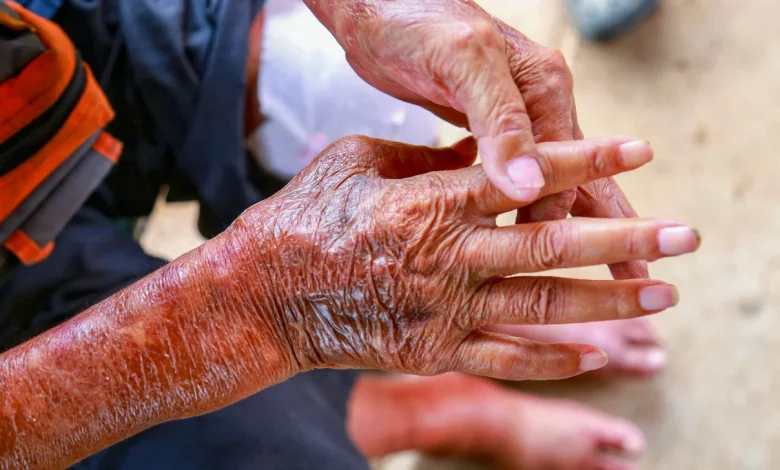Scleroderma Symptoms, Causes, Diagnosis and Treatment

What Is Scleroderma?
It is not a particular disorder, rather a group of disorders which roots skin hardening and constriction. The autoimmune disorder is also accountable for tightening and hardening the connective tissues, responsible for our overall body structure and outline.
What Are The Symptoms Of Scleroderma?
The prominent symptoms of scleroderma is the thickening, tightening or hardening of your hands, arms, legs, feet, face, and fingers skin. Few common symptoms of scleroderma are:
- Pain, stiffness or swelling in your hands, face, feet, toes or fingers.
- Discolored skin.
- Puffy skin.
- Telangiectasias, which are the red colored spots on your tongue, lips, face, palms or fingers. They emerge due to widened blood vessels.
- Reaction of toes and fingers to cold.
- Fatigue.
- Sores or ulcers in your elbows, knuckles or fingertips.
In addition to this, scleroderma can also target your connective tissue, muscles and other organs merely depending upon what form of condition you are suffering from. In case this happens, you might observe: - Breathing difficulties due to lung or heart damage.
- Digestion problem.
What Causes Scleroderma?
It occurs when your body makes and gathers excessive collagen in tissues. Basically, collagen is a kind of protein which is responsible for making the connective tissues of our body.
Furthermore, experts believe immune system of a body plays an active role in the overproduction of collagen. Since scleroderma is an autoimmune disease, immune system of the person attacks against the body itself, ensuing in inflammation and overproduction of collagen. Though, experts have failed to understand what sources this!
What Are The Risk Factors Of Scleroderma?
Certain factors identified for increasing the risks of Scleroderma are:
- Gender: females are 4 times more probable to develop sclerderoma as compared to males.
- Environmental factors: exposure to silica dust and specific industrial solvents for example paint thinners increase the chances of developing the disorder.
What Are The Potential Complications Of Scleroderma?
Its complications may range from mild to severe. Few of which are:
- Raynaud’s complications.
- Lung complications.
- High blood pressure.
- Renal crisis.
- Heart failure.
- Arrhythmias.
- Pericarditis.
- Dry mouth.
- Tooth decay.
- Erectile sysfunction (males).
- Decreased sexual lubrication (females).
- Thyroid.
- Underactive intestines.
- Affected muscles and joints.
How Is Scleroderma Diagnosed?
Since the disorder tend to occur in many forms and develop slowly, diagnosing it can be difficult. Experts believe that no particular test can corroborate scleroderma.
During your visit, the doctor will conduct a physical exam. He or she will ask questions related to your symptoms and will suggest the following tests:
- Skin biopsy.
- Blood test.
- Fingernails.
- Tests to determine any gastrointestinal, heart or lung complications.
How Is Scleroderma Treated?
Unfortunately, there is no effective treatment present today that can help cure the disorder. None of the medication has proved to stop the abnormal growth of collagen. Though, few of its medicines may help prevent complications in the long run and ease its symptoms.
Few treatment options of scleroderma include:
- Medications.
- Therapy.
- Surgery.
Related Articles :
Ecthyma Symptoms, Causes, Diagnosis and Treatment
Diaper Dermatitis Symptoms, Causes, Diagnosis and Treatment
Chronic Lymphocytic Leukemia Symptoms, Causes, Diagnosis and Treatment
Bartonellosis Symptoms, Causes, Diagnosis and Treatment
Pruritus Symptoms, Causes, Diagnosis and Treatment
Measles Symptoms, Causes, Diagnosis and Treatment
Keratosis Pilaris Symptoms, Causes, Diagnosis and Treatment
Impetigo Symptoms, Causes, Diagnosis and Treatment
Idiopathic Thrombocytopenic Purpura Symptoms, Causes, Diagnosis and Treatment
Ichthyosis Vulgaris Symptoms, Causes, Diagnosis and Treatment
Seborrheic Keratosis Symptoms, Causes, Diagnosis and Treatment
Porphyria Symptoms, Causes, Diagnosis and Treatment
Polycythemia Vera Symptoms, Causes, Diagnosis and Treatment
Hidradenitis Suppurativa Symptoms, Causes, Diagnosis and Treatment
Hyperhidrosis Symptoms, Causes, Diagnosis and Treatment
Lichen Planus Symptoms, Causes, Diagnosis and Treatment
By : Natural Health News




